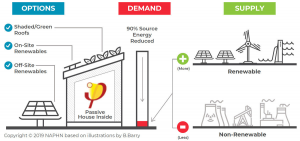“The City understood that more Passive House projects would be needed to serve as the icebreakers, making way for all buildings to move toward high-performance outcomes.”
Vancouver is heading to very low carbon buildings, a profitable path to zero carbon, by focusing on their Zero Emissions New Building Plan, which focuses on the lessons from Passive House (better envelopes, lower heating energy, less use of fossil fuels).
I heard Chris Higgins speak about this in Wellington at the South Pacific Passive House Conference (by screencast, to avoid the emissions generated if he’d travelled here to address us in person) and at the International Passive House Conference in China. At both events, he underscored the first step was removing barriers to using Passive House as a high-performance solution. Then the City started adding incentives and investing in staff training.
In his words, “When I looked at Passive House I could see it was a well thought out and well-executed ‘big bold idea’ for buildings. Local leaders helped by designing the first few Passive House projects, proving this approach is realistic. Those projects blazed the trail for the City to step in, remove barriers, get trained up, and put in place incentives to build market interest.”
The result? Vancouver now has 50-storey plus high-rises, single-family homes, fire halls and childcare facilities certified to Passive House standards, “along with everything in between”.
And, the City has set a big, bold goal to run only on renewable energy by 2050.
Image credit NAPHN
— 18 March 2020
